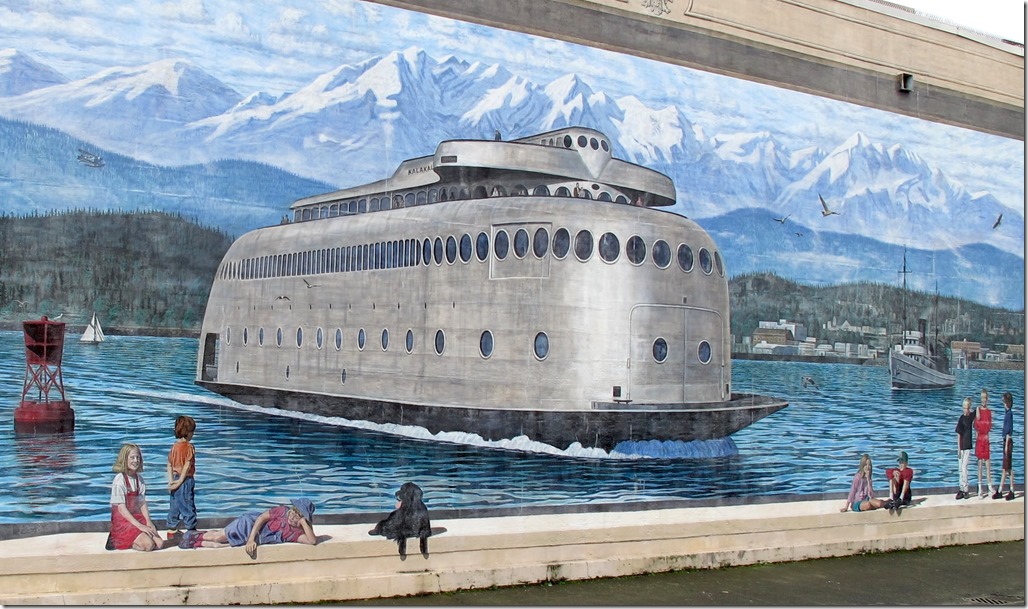 When I first came to this area many years ago, I heard the name “Kalakala”—and since I was in the broadcast business, my first thought was that it was the longest set of call letters I’d ever heard.
When I first came to this area many years ago, I heard the name “Kalakala”—and since I was in the broadcast business, my first thought was that it was the longest set of call letters I’d ever heard.
The name was so long—and redundant—that when people said it, it was hard to know where to stop.
But as old-timers (or new-timers who are paying attention) know, the Kalakala was the name of our ferry system’s most iconic vessel—if you give exception, of course, to Ride the Duck.
The Kalakala was the star attraction of what used to be called “The Black Ball Ferry Line.”Bing Crosby and the Andrew Sisters—who were the Justin Bieber and Spice Girls of their day—even sang about the legendary enterprise.
Listen to this catchy tune. It’s a chestnut, but you’ll hear mention of several ferries—including the one this column is about. “The Black Ball Ferry Line (1951)”
The Kalakala was retired in 1967, but had operated since 1935—and even before that as a ferry under a different name. After getting mothballed (turns out moths have no taste for metal)—someone towed the old boat to a seafood processing company in Kodiak, Alaska—where it spent several years as a cannery. Some saw that as a bit ironic, since the old ferry itself looked something like a ham container.
In 1998, it was rescued and towed all the way back to Seattle where plans were hatched to refurbish it and perhaps make it into a museum. Personally, I always thought the vessel could somehow be attached to the Experience Music Project—where its strange shape would blend right in.
Maybe it could be resurrected as a Greek restaurant featuring Kalakala baklava.
Or it might become a bagel place offering Kalaka-lox.
With a bit of sprucing up, the old ferry could even be placed on a waterfront pier and turned into an espresso stand. I can taste that Kalaka-latte’ right now.
But no, none of that is destined to happen—because after languishing for years at a mooring in Tacoma, it was announced recently that the end of the line had finally come for the old girl—who looks much more like an old boy by now—a boy named Rusty.
In 2011, the Coast Guard declared the crumbling ship a hazard to navigation. (That same day, they declared a guy named Larry—who has a 2010 Sea Doo—also a hazard to navigation. But that’s another story. )
Later this month, the Kalakala is scheduled to be scrapped. Human beings die and get a eulogy. Old ferries die—and get scrapped.
It’s hard to appreciate it now, but in its glory days, the Kalakala was—well—glorious.
Its shimmering metallic exterior and art deco design made it look like the largest and hippest floating toaster in the world.
Sometimes I lament all the old noises there used to be in this world of ours, that are now
extinct, or nearly so. Like the clickety-clack of the keys on a manual typewriter.
Or that huge whooshing sound that emanated from your TV when a station would sign off at night. Nobody signs off anymore—they stay on the air all night now with essential programs about Bowflexes and juicers.
Noises like clunky slide projectors, the old man’s 8mm film projector—and those distorting speakers at drive-in movies—are all pretty much gone now.
Also gone: The sound of guillotines. So it’s not all bad.
But by all accounts, the Kalakala was famously ear-splitting—with a cacophony of clanking from the engine and heavy vibrations throughout—it got people where they were going, while also loosening their teeth.
The Kalakala didn’t always get the love it deserved. Some called it the “Silver Slug,” or the “Silver Beetle”—and sometimes the “Galloping Ghost of the Pacific Coast.”
That last nickname seems most apt now—because one of the icons that made Seattle, Seattle—is about to vanish forever.
Kalakala is said to be a Chinook word meaning “bird.” For a time, it was very much more eagle, than turkey.
Farewell, Galloping Ghost.
